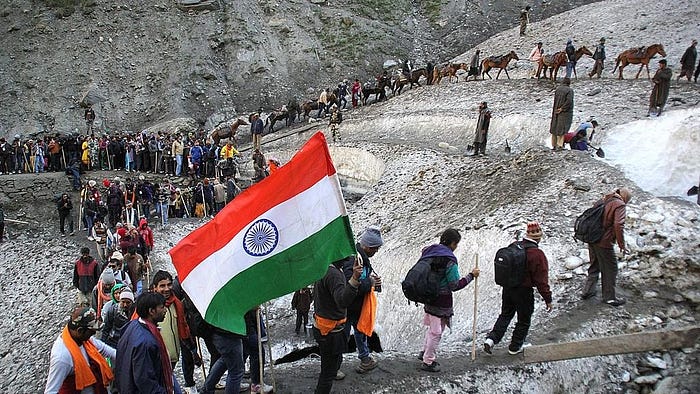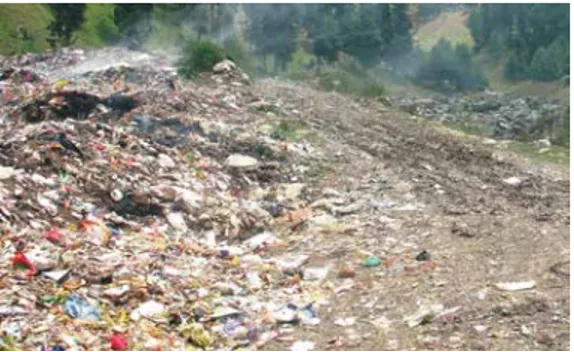Amarnath Yatra: Use of Religious Pilrimage for Settler-Colonization
September 01, 2023
Indian-occupied Kashmir.

Kashmir is currently in the midst of the longest Amarnath Yatra ever (62 days), even in the face of climate change and rising global temperatures. What is the Amarnath Yatra, what are its effects, and how is it a tool of India’s settler-colonial project in Kashmir?
What is the Amarnath Yatra?
It is an annual Hindu religious pilgrimage organised and facilitated by the government of India. During this pilgrimage, Hindus from different parts of India visit the Amarnath cave located in the Pahalgam valley of Kashmir’s Islamabad district. The end point of the journey is an ice-stalagmite located in a cave, which is believed to be a Shiva lingam that is regarded holy by Hindu.
In the recent past, the yatra used to last about 45 days (it has lasted 60 days in some years), during which hundreds of thousands of Hindus visited Kashmir. However, this year the government has increased the duration to 62 days, which is the longest in the history of the pilgrimage, in order to allow more pilgrims to make the journey.
Origin of the Yatra
In terms of the origin of the current day Amarnath Yatra, there are several different narratives. Some of these narratives have been documented by the 2017 report by JKCCS titled “Amarnath Yatra: A Militarised Pilgrimage” . According to one of these narratives, in 1850 a Muslim shepherd named Buta Malik was grazing his sheep in the meadows of Pahalgam when he discovered what is currently referred to as the “Holy Amarnath Cave”. In other Hindu narratives, there have been attempts to trace the origin of the yatra to the ancient period, meaning that Buta Malik only “re-discovered” the cave.
Historically, the report quotes that the yatra first received state patronage in 1846, when the British sold Kashmir to the Dogras, Hindu rulers from the region of Jammu. The Dharmarth Trust was established in the same year by the Dogra kings to oversee Hindu religious institutions. The establishment of a pilgrimage to the newly “discovered” cave was seen as a means for Hindu rulers to assert legitimacy over their Muslim subjects and territories — thus, this pilgrimage has had political motivations even in the past. Consequently, the present-day rituals and beliefs associated with the Amarnath Yatra can be traced back to approximately 150–160 years. The 2017 report tries to verify all the different claims associated with the origin of the yatra. However, it concludes by saying that the claims cannot actually be verified as the sources being referred to do not either refer to the Amarnath Cave in Pahalgam directly or refer to it only after the 19th century, when it had already been popularised by the Dogras.

Evolution of the Yatra Over the Years
As the Dogras tried to popularise the Amarnath Yatra since the late 19th century, they were never really able to fully integrate it into the social fabric of Kashmir, despite a considerable presence of Kashmiri Pandits (Hindus) in Kashmir. The 2017 report quotes several Kashmiri Pandits, saying, “while some people go for the yatra, it is not deemed religiously significant.” The report further quotes them saying, “there has been no specific tradition to visit the Amarnath on Shravan Poornima, instead the community visits a Shiva temple in the vicinity of their homes.”
However, since the 1980s, the yatra has seen a considerable resurgence. As the collection of data for the number of yatris began in 1963, the biggest jump was between 1980 and 1985. In 1980, a mere 2000 yatris visited the cave, while in 1985, the number soared to 42,000. The surge in these numbers coincides with the rise of far-right Hindu militant outfits in india. The Vishwa Hindu Parishad (VHP) and its subsidiary Bajrang Dal were very proactive during this time to revive Hindu nationalism. This was achieved in two ways in the case of the Amarnath yatra. First, government support, which had been marginal until this time, grew to the position of becoming instrumental in making the yatra a success and conducting it smoothly. Secondly, the length of the yatra was gradually increased to facilitate more participation from all over india.
In the 1990s, a deliberate effort was made to associate the pilgrimage with an indian nationalist agenda, serving as a means to counter Kashmiri demands for freedom from india. In 2001, the indian government took full control of the yatra through the creation of the Shri Amarnath Yatra Shrine Board (SASB), asserting complete state patronage and ownership under the guise of providing essential amenities to the yatris.
The establishment of the Board served not only as a means of ensuring state patronage but also as a facade for the deployment of indian armed forces. It also became a mobilization tool, urging people in india to participate in the Yatra and demonstrate their loyalty to the country. The religious nature of the Yatra was transformed into a call for national pride, as evident in a 1997 Press Information Bureau Feature Release:
“Faith can move mountains, so goes an old adage. With a little variation to the saying, it is hoped that the yearning for Moksha (salvation) can move the devotees to the challenging heights of Kashmir. This will also be a befitting gesture of solidarity with our valiant soldiers who have been fighting the enemy to defend our borders.”
The 2008 Unrest — The SASB Land Transfer Row
In 2008, the Government of India proposed the transfer of a 100 acres of forest land in the name of the SASB, to construct huts and other infrastructure for Amarnath yatris. The pro-freedom leadership of Kashmir suspected that the transfer was a bid to settle non-local Hindus in Kashmir. This led to a 2-month long agitation and protests around Kashmir. More than 100 civilians died, and more than a 1000 people were injured as indian forces kept firing live ammunition directly at the protestors. Even though the land transfer was ultimately cancelled, it was agreed that the Shrine Board would build temporary infrastructure on forest land during the yatra time.
The indian state is effectively functioning as a Hindu state, granting preferential treatment to Hindus as first-class citizens while relegating others to second-class status. In Kashmir, this takes on a distinct meaning due to its status as a colonized territory, where democratic structures are merely a facade and military rule is dominant. The use of militarization to suppress dissent and the struggle for freedom, coupled with the exploitation of religious sentiments of the Hindu community in india, converge in a dangerous manner within the context of the Amarnath Yatra.
Rise and Fall in the Number of Yatris — A Brief Timeline:
Since the 1990s, when a full-fledged armed resistance in Kashmir started, the yatra has been used a tool to enforce a stronger indian claim on Kashmir. When in 1996, a group of Kashmiri rebels announced a ban on the involvement of Kashmir in providing logistical support to the yatris in wake of killings and brutalities across the region, Bajrang Dal responded by issuing a ‘Chalo Amarnath’ call all over india. They were able to mobilise more than 50,000 people, with 21,000 being youth members of the Bajrang Dal This caused a sudden spike in the number of yatris from 60,000 the previous year to 120,000 in 1997. Similarly, in wake of the Amarnath land row of 2008, various Hindu organisations tried to mobilise more people for the yatra, “in a show of Hindu might”. Now, this year the yatra is slated to last for 62 days and this will make it the longest in history. The rise in numbers is expected to be steep as the Shrine Board announced to have already completed 300,000 registrations as the yatra just began on the 1st of July. These numbers are expected to show an exponential increase in the next one and a half month.
Environmental Impact of the Amarnath Yatra
The unregulated influx of visitors to Amarnath raises significant concerns, considering the sensitive environment of the region and its crucial role in providing water and environmental stability. The Special High-Power Committee (SHPC) constituted by the Supreme Court of India in the year 2012 to address growing casualties during the yatra, acknowledged the fragility and vulnerability of the ecosystem, and emphasized the necessity to assess, minimize, and control the impact of human activities. However, the SHPC’s specific recommendations overlooked certain issues which are direct consequences of the yatra such as noise pollution, the adverse effects of helicopters on glaciers, the rivers Lidder and Sindh, as well as the forests and meadows.
Though there has always been a plethora of environmental concerns with the yatra, the SHPC was constituted for the safety of yatris and not to probe the environmental concerns. Similarly, there have been committees like the Sengupta Committee of 1996 and the Mukherjee committee of 2000, which were constituted for the safety of the yatris. However, they recommended regulating the number of yatris that should be allowed to travel the fragile landscape on a daily basis. It was not until 2006 that a report (the Jammu & Kashmir Pollution Control Board — J&KPCB) was finally published that addressed the environmental concerns and again recommended regulating the number of daily yatris on both routes. However, these recommendations have never been implemented, neither in the name of yatra safety, nor in the name of environment, indicating that the purpose of the journey is perhaps way bigger than just being a religious pilgrimage. Furthermore, a response to an RTI filed with the Shrine Board confirmed that neither has any carrying capacity study been conducted to determine the number of yatris per day or season, nor has any environment impact assessment of the entire Yatra been conducted.
Sanitation and Solid Waste
According to a 2009 report, the average waste generated by the yatra per day was an astonishing 55,000 kgs. It has been 14 years since this study and as the longest yatra in the history is underway, this waste generation would only have gone up manifold. While the SASB claims to have Sewage Treatment Plants (STPs) and temporary toilets in place, it also claims to collect municipal waste from the higher camps and routes. However, according to the JKCCS report, residents of Pahalgam and Sonamarg have never seen this collection happen in reality. Even in terms of the STPs and temporary toilets, until 2014 the Nunwan STP in Pahalgam was reportedly non-functional while locals have complained the temporary toilet pits to be too shallow. This shallowness results in the waste overflowing into Lidder and Sindh rivers, leading to the drastic pollution of both the water bodies.
Over and above these issues, the usage of plastics remains widespread during the Yatra, despite efforts to reduce it through the distribution of cloth bags. Plastics in the form of water bottles, polythene for rain protection of clothes, and the use of plastics and tetra packs by the langars have not been adequately addressed. The SASB themselves acknowledged this during a post-Yatra review meeting in 2014.

Broader Environmental Concerns
The rise in global temperatures has contributed to a reduction in snow accumulation in the higher mountains. Conversely, fast-melting snow results in a shorter period of water availability. The Yatra needs to be seen in this context of climate change. The additional stress that the high altitudes will see due to the presence of hundreds of thousands of people, as well as the sudden increase in heat (due to cooking, use of lights, and simply body heat of up to a million people) exacerbate the melting of glaciers. This will lead to an imbalanced water supply, increased mountain erosion, flash floods, dam breaches, landslides, and avalanches. This will not make too much of a difference to the yatris, since it is neither their lives nor homes that are made vulnerable.
Kashmir is also located in seismic zone V, which makes it a high-risk zone for earthquakes. During the past 2 decades, more than 100 earthquakes have rocked the region, with most devastating one striking in 2005 which resulted in more than 1300 deaths while more than 6000 were injured. With climate change being linked to seismic activity , it is not tough to gauge what effect a pilgrimage of the size of the Amarnath yatra can have on a high earthquake risk zone.
Hindutva, Settler-colonialism, and Amarnath
In the aftermath of the abrogation of the semi-autonomous status of Kashmir in 2019, as india moves its settler colonial project in Kashmir rapidly to effect substantial demographic change, the increase in the yatra period to 62 days this year is a clear indication of how Hindu religious tourism is being made subservient to the same agenda. Even though the ecologically fragile zone may not be able to tolerate such an influx of people over a longer period of time, the indian government is leaving no stone unturned in the “Hindu-isation” of Kashmir which serves the broader Hindutva project and allows the Indian state to establish stronger claims on the region.
Stay in touch with Stand with Kashmir.
Stand With Kashmir (SWK) is a Kashmiri-driven independent, transnational, grassroots movement committed to standing in solidarity with the people of indian-occupied Kashmir in ending the indian occupation of their homeland and supporting the right to self-determination of the pre-partition state of Jammu and Kashmir. We want to hear from you. If you have general inquiries, suggestions, or concerns, please email us at info@standwithkashmir.org.
©2025 StandWithKashmir All rights reserved. SWK is a 501(c)(3) non-for-profit organization.






Leave a Reply